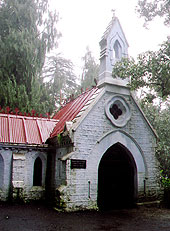 |
 |
 |
| SEPIA HUES: (From top) Entrance to the cemetery; a close-up of the gate; Ruskin Bond |
Most of the plaques that line the ancient walls of Christ Church in Mussoorie ? the oldest church in the Himalayas ? date back to the 1800s. In the ornate calligraphy that adorns their marble facia are remembered several men and women, to have breathed their last in the Subcontinent they had come to make their own. Faithful servants in Her Majesty’s Service, brave lieutenants in the Bengal Army and their doting wives all find a place by the pews in the hallowed portals of the hall. So does John George Lang.
Amid the antiquity, however, the plaque in memory of the “barrister, writer, journalist, wanderer, editor of The Moffussilite, the first Australian-born novelist... a brilliant and restless soul”, stands out in stark contrast. The dates (born 19 December, 1816; died 24 August, 1864) place the inscription in temporal context to its surroundings, but the physical brilliance is somewhat incongruous. Unveiled by the Australian high commission on August 15 this year, it is a belated tribute to a man who was long forgotten, only to be remembered again. If only metallic sheen could make up for lost time.
“Lang was a resident of Mussoorie in the later years of his life,” says Reverend Eric Templeton, priest of the church. “The church records show that he was a member of the church, and reveal that his last rites were performed by the then Christ Church chaplain. Since his death, however, he has been a forgotten man, and would have remained so had Ruskin Bond not stumbled upon his grave,” he says.
The story goes like this. It was after coming across Lang’s reference in a book called John Lang and the Forger’s Wife, written by Australian writer Nancy Keesing, that Ruskin Bond ? a resident of Landour in Mussoorie ? began research on the Australian expatriate’s legacy in the hill town. On one of his excursions to the Camel’s Back Cemetery in Mussoorie in 1964, Bond discovered Lang’s grave, obscured by shrubbery.
“In course of time, I came across a few of his writings, which were reproduced and sent to me by a friend from England, and found them to be an interesting account of life in north India in the days before the Sepoy Mutiny in 1857,” says Bond.
The writer eventually used one of Lang’s short stories, titled The Meerut Graveyard, in The Book of Indian Ghost Stories that he edited.
“It wasn’t really a ghost story,” says Bond. “But it was kind of spooky, so I decided to use it.” That apart, Bond also used an extract from Lang’s The Himalaya Club, written about the club of the same name in Mussoorie, in his book The Lamp is Lit: Leaves from a Journal.
There was a motive for Bond’s decision ? he wanted the world to read the works of one of the earliest chroniclers of India in the English language. “He verged on the melodramatic, was satirical at times and loved to exaggerate and sensationalise things,” says Bond of Lang’s style. “He wrote fiction that was quite racy compared to contemporary literature. But his travelogues, on the other hand, brought to prominence the little details of life in north India.”
Born in Parramatta, Australia, Lang had gone to England where he earned a degree in law. He migrated to India at the age of 25, to practise law in Calcutta, where his brother was already settled. In the mid-19th century, Lang moved to Meerut, which was then a bustling British cantonment. With a journalistic bent of mind, Lang soon began to edit and print a newspaper called The Moffussilite out of Meerut. “He presumably wrote half of it himself,” says Bond. “And it probably had a fairly good readership.”
A lover of the country he lived in and its people, Lang had also begun to exercise his legal expertise for Indians. “Lang represented Indians, including the Rani of Jhansi, in their legal fights against the East India Company ? which did not earn him friends among the British authorities,” says the Australian high commission.
Bond adds that Lang had once represented an Indian worker who had not been paid by the East India Company. “He had a knack for such radical things,” he says. Yet Lang maintained considerable social repute. “He liked to socialise and was supposedly a heavy drinker too.”
Lang wrote some 11 novels during his lifetime, apart from several plays, short stories and travelogues. Some of his writings also appeared in Household Words, the magazine published by Charles Dickens in England during the 1850s.
Despite Bond’s efforts to popularise Lang and his works among 20th century readers, Lang remained an obscure figure till Rory Medcalf, former spokesperson of the high commission, undertook some painstaking research to give Lang his deserved pride of place. “What probably moved Rory was the fact that Lang, being the first Australian-born novelist, was not recognised in Australia,” says current high commission spokesperson John Fisher. “It was a lacuna in Australian literature that he felt needed to be filled.”
Starting in late 2002, Medcalf went on to collaborate with fellow Australian Victor Crittenden ? a former librarian and scholar of 19th century Australian literature ? on his project. A biography of Lang, written by the latter and titled John Lang: Australia’s Larrikin Writer is slated to be published in Canberra sometime in September.
Back in India, Bond has his own take on how to popularise the late writer. “His books are all out of print and one can only find copies in museums,” he says. “However, if the Australian authorities could arrange for reproduction of Lang’s works from the archives, I could write an introduction and request publishers to publish the works once again. That would perhaps be the best way to make today’s readers familiar with his works.”
It’s a plan Medcalf has apparently had at the back of his mind as well, says Fisher. “If a publisher shows adequate interest in publishing Lang’s works, we would do all we could on our part to get the works back in print. We would welcome such a gesture,” he adds.
That’s not to say that Lang’s grave in Mussoorie would become a tourist attraction in the years to come. Some things are best left untouched.










